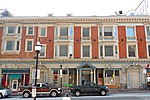Woman's Industrial Exchange
Baltimore National Heritage AreaCommercial buildings on the National Register of Historic Places in BaltimoreDowntown BaltimoreHistory of women in MarylandHouses completed in 1815 ... and 2 more
Industrial history of MarylandWoman's Exchange movement

Woman's Industrial Exchange is a historic building located at 333 North Charles Street, Baltimore, Maryland, United States. It consists of a townhouse erected in 1815, with a large, five-story structure appended to the rear. The building was purchased in 1860 by Mrs. Mary E. Boardley for a boarding house, and she added the rear wing. The Exchange purchased the building in 1889. A shop window was added circa 1900, which enhances the fine Flemish bonded brick work and marble stoop. The mixed-use building houses the shop and offices of The Woman's Industrial Exchange, two restaurants, and seven residential apartments.
Excerpt from the Wikipedia article Woman's Industrial Exchange (License: CC BY-SA 3.0, Authors, Images).Woman's Industrial Exchange
North Charles Street, Baltimore Downtown
Geographical coordinates (GPS) Address Nearby Places Show on map
Geographical coordinates (GPS)
| Latitude | Longitude |
|---|---|
| N 39.293333333333 ° | E -76.615277777778 ° |
Address
Verizon
North Charles Street 323
21201 Baltimore, Downtown
Maryland, United States
Open on Google Maps









